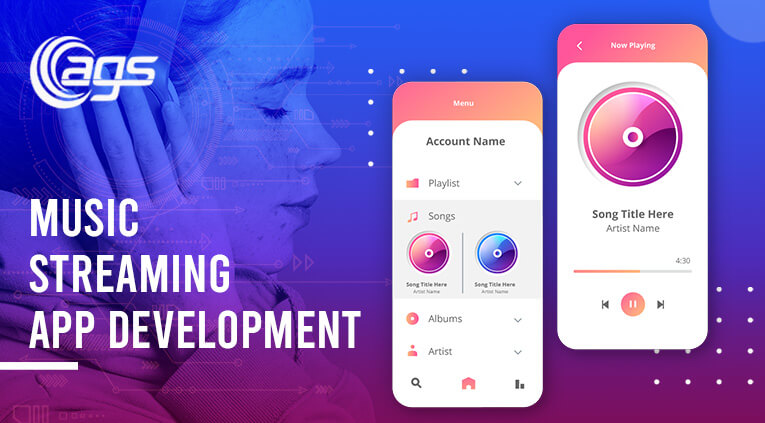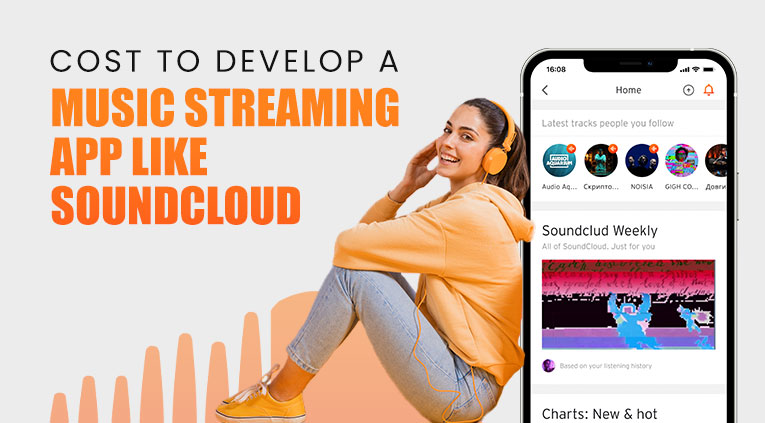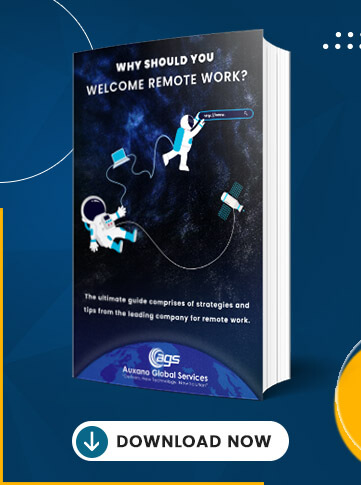Pandora is a popular music streaming app that allows users to create personalized radio stations based on their music preferences. The app has gained massive popularity over the years, and many entrepreneurs and businesses are looking to develop a similar app to Pandora. Whether you are an entrepreneur or a business looking to enter the music streaming industry, understanding the development cost and monetization strategies is crucial to success.
Now before delving into how much it costs to develop an app like Pandora, explore what it actually is and how it works…
What Is Pandora & How Does It Work?
Pandora was one of the first Music Streaming services since 2000. The platform initially allowed users to create virtual radio stations starting from the insertion of a song or an artist liked by the user.
The new app will offer new features such as the selection of songs or playlists instead of the classic radio stations, and it will also be possible to play songs offline by downloading them directly to the smartphone. Also noteworthy is the new, improved user interface for iOS and Android mobile applications; simple to use and with a background color those changes according to the song being played and its cover.
Pandora Premium begins its adventure in a market dominated by Spotify, with 50 million paying users, and Apple Music, with over 20 million subscribers. The internet radio platform is completely renewed by offering users new features already present in the various Spotify Premium or Apple Music, but which will certainly be worth a lot for all aficionados of Pandora’s conceptually different streaming system.
Let’s get into some statistics revealing how the music streaming app industry is booming…
Insights of Music Streaming Apps with Statistics
Music streaming apps have been reshaping the music industry for the past two decades. Napster, Limewire, and BitTorrent were the pioneers of music sharing in the early 2000s; however, they were taken down for unauthorized use of copyright material. Apple’s iTunes store and iPod launched in 2001, providing users with a legal way to buy music online. The success of the iPod encouraged other companies to develop audio streaming platforms and applications. In the mid-2000s, Pandora and Spotify were launched, offering a new way of listening to music for users.
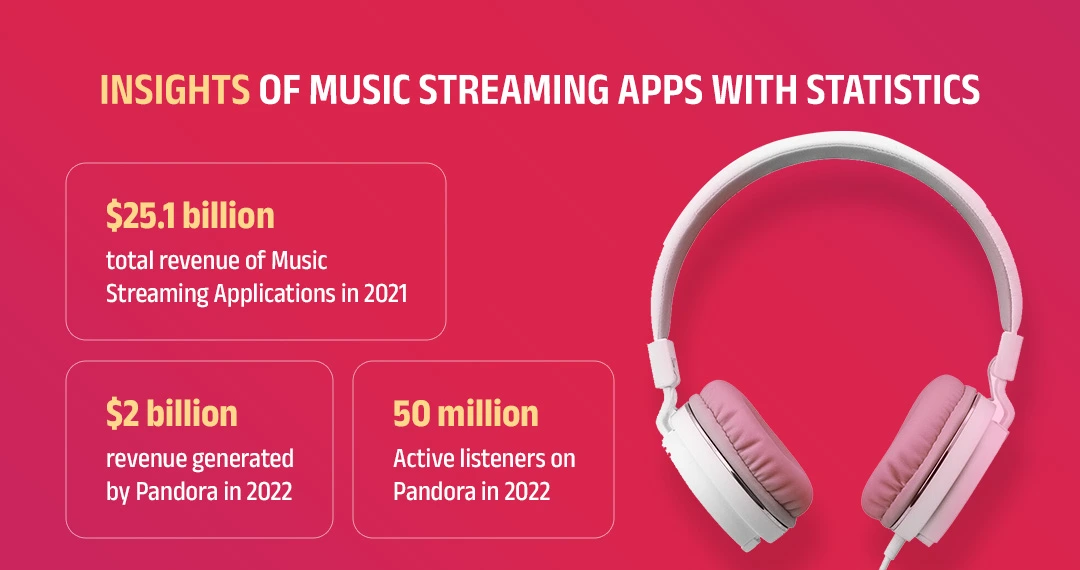
In recent years, Music streaming applications have become increasingly popular, generating total revenue of $25.1 billion in 2021. This represents a 32% increase from the previous year. Revenue from music streaming has increased every year since 2010, growing at an average rate of 43.9% from 2014. Music streaming is now the primary revenue source for music labels, which highlights the impact that these apps have had on the industry.
Pandora is one of the largest audio streaming platforms, generating $2 billion in revenue in 2022. However, this only represents less than 1% growth in the previous year. The number of monthly active listeners on Pandora has been steadily declining since 2016, with 50 million listeners in 2022. Pandora also experienced a small decline in the number of paid subscribers, with 6.2 million subscribers in 2022, compared to 6.3 million in 2021.
All these statistics reveal how music streaming apps have revolutionized the music industry and provided users with a convenient and affordable way to listen to music. The statistics highlight the increasing popularity of music streaming apps and the impact they have had on the music industry. But the question arises, how are these Music streaming applications monetized and generate revenue? Don’t worry; the following section reveals some monetization strategies to earn through your music-streaming app.
Monetization Strategies for Music Streaming Apps like Pandora
For all those wondering how to generate revenue from your music streaming app like Pandora, Here are some of the best monetization strategies that can help:
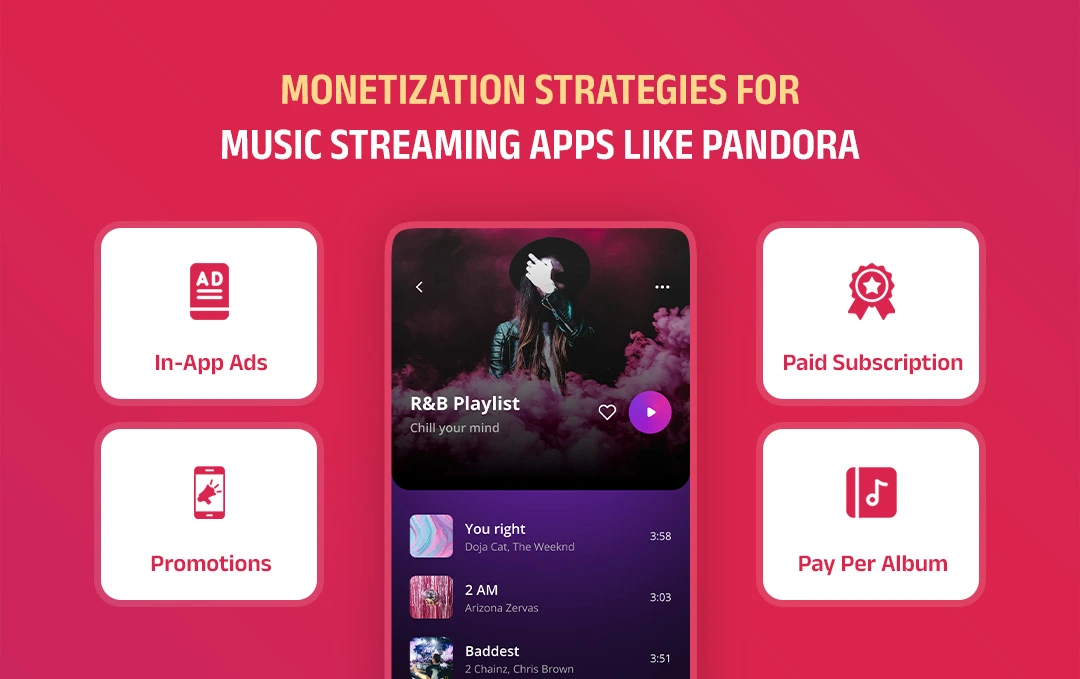
1. In-App Ads
In-app ads are one of the most common monetization strategies for Music streaming applications like Pandora. This strategy involves displaying ads within the app, which can be either audio or visual. The revenue generated from these ads is shared between the app developer and the advertiser. The cost per ad can vary depending on various factors, such as the ad’s placement, format, and targeting.
In-app ads can be a great way of generating revenue for the app developer, but they can also affect user experience if not implemented correctly. Therefore, it is essential to strike a balance between ad frequency and user experience to ensure that the app remains popular among users.
2. Paid Subscription
A paid subscription is another popular monetization strategy for audio streaming platforms that involves offering users a premium version of the app, which offers additional features, such as ad-free streaming, unlimited skips, and offline listening. The revenue generated from paid subscriptions is a recurring monthly or annual fee paid by the users. Paid subscriptions can be a reliable source of revenue for the app developer, as it offers a steady stream of income. However, it is crucial to offer value to the users to encourage them to pay for the premium version.
3. Promotions
Promotions are a great way of generating revenue for music streaming apps like Pandora. This strategy involves partnering with music labels and artists to promote their music within the app. In return, the app developer receives a percentage of the revenue generated from the sales of the promoted music. Promotions can be a win-win situation for both the app developer and the music industry, as it offers exposure to new music and generates revenue for both parties.
4. Pay Per Album
Pay per album is a unique monetization strategy for music streaming apps, which involves allowing users to purchase music albums within the app. The revenue generated from the sales of the albums is shared between the app developer and the music label. This strategy offers users a sense of ownership over the music they listen to, and it can be a great way of generating revenue for the app developer. However, it is essential to ensure that the cost of purchasing an album is reasonable and competitive compared to other music platforms.
The above monetization strategies play a crucial role in determining the success of a music streaming app. However, developing a music streaming application involves several factors that can affect its cost; let’s see how in the section below.
What Factors Affect the Cost of Music Streaming App Development?
Music streaming apps like Pandora have become increasingly popular over the past few years. However, the development of such apps can be expensive and time-consuming. Several factors can influence the cost of music streaming app development.
In this section, you will explore the different factors that affect the music streaming app development cost.
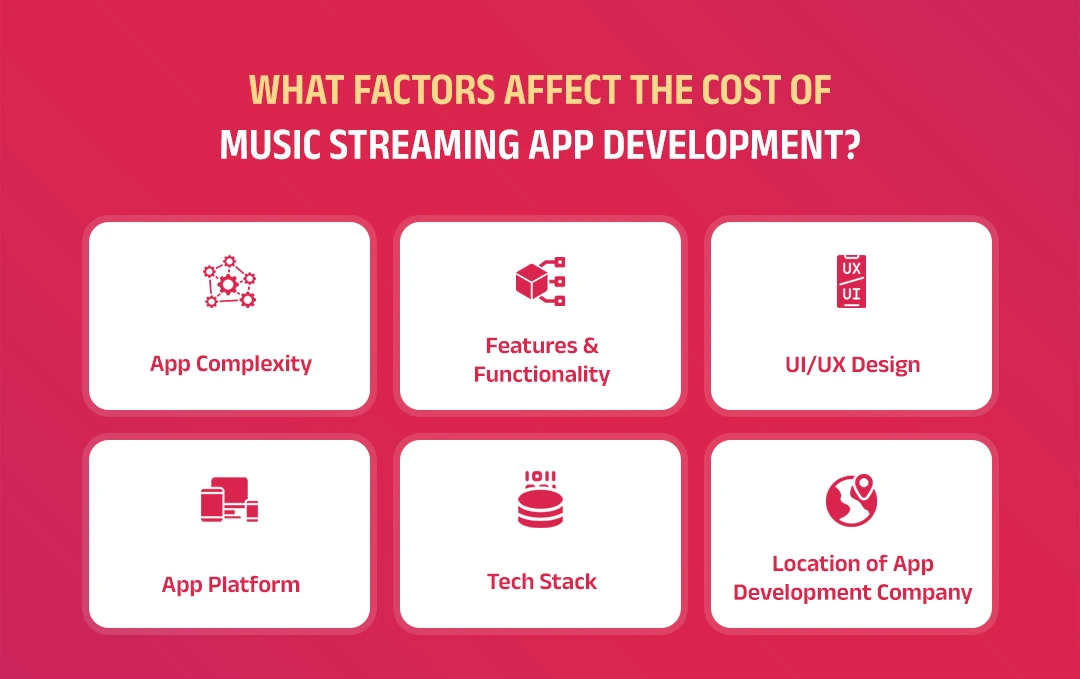
1. App Complexity
The complexity of the app is one of the most significant factors that affect the cost of mobile app development. The more complex the app is, the more expensive it is to develop. A music streaming app like Pandora, for example, is quite complex, and it requires a team of experienced developers to create it.
A music streaming app involves several features, including music recommendations, personalized playlists, user profiles, social sharing, and more. Each of these features requires careful planning, design, and development. Furthermore, these features need to be integrated seamlessly into the app, which requires a significant amount of time and effort.
2. Features & Functionality
The features and functionality of a music streaming platform also play a significant role in determining the cost of development. The more features the app has; the more expensive it is to develop. A music streaming app has a wide range of features that make it stand out from its competitors. For example, Pandora’s Music Genome Project is a unique feature that helps users discover new music based on their listening habits.
Other features that can impact the music streaming app development cost include social sharing, song lyrics, song identification, offline playback, and more. Each of these features requires additional development time, which can increase the overall cost of development.
3. UI/UX Design
The user interface (UI) and user experience (UX) design of the app can also impact the cost of development. A music streaming app requires an intuitive, easy-to-use interface that allows users to navigate the app effortlessly. The app needs to be visually appealing and provide users with a unique experience.
The design of the app requires careful consideration, including the color scheme, typography, icons, and more. The UI/UX design is crucial to the success of the app, and a poorly designed app can lead to a high churn rate. Auxano Global Services offers the best music streaming app development service with a strong focus on UI/UX design and ensures that the app is intuitive and easy to navigate. We also have expertise in developing robust tech stacks that can handle a large number of users and provide a seamless experience.
4. App Platform
The platform on which the app will be developed can also impact the cost of music streaming app development services.
Music App Development for cross-platforms can increase the app’s reach and provide a better user experience for users who use different devices.
Developing an app for cross-platforms is comparatively cheaper than native platforms (iOS and Android) since there is no need to hire separate resources.
5. Tech Stack
The tech stack used to develop the app can also impact the cost of development. It includes the programming languages, frameworks, libraries, and tools used to develop the app. choosing the right tech stack is crucial to the success of the app. If you are planning to create your own music streaming app, you must know that a music streaming app requires a robust tech stack that can handle a large number of users and provide a seamless experience.
The tech stack used to develop the app can impact the app’s performance, security, scalability, and more, and that’s why professional music streaming app development services are recommended.
6. Location of App Development Company
The location of the Music Streaming App Development Company can also impact the cost of development. It varies significantly depending on the location of the development company. Developing an app in a high-wage country, such as the United States or Canada, can be significantly more expensive than developing an app in a low-wage country, such as India. The location of the app development agency can also impact the quality of the app. developing an app in a country with a high concentration of experienced developers can lead to a higher quality app.
While the location of the Mobile App Development Company can impact the cost and quality of development, it’s also essential to choose a reliable and experienced agency. One such company is Auxano Global Services, we are a leading Music Streaming App Development Company specializing in developing such apps. We have a team of experienced app developers who are well-versed in developing apps for both iOS and Android platforms, and we ensure that the app we build will be user-friendly and visually appealing.
After understanding all the factors affecting the music streaming app development cost, let’s see how much it will actually cost…
How Much Does It Cost To Develop a Music Streaming App like Pandora?
Developing an app like Pandora can be an expensive and complex process, and the costs associated with the development of such an app can vary depending on several factors. The cost of development can range anywhere from $40,000 to $250,000 or more, depending on various stages of development, features, platform, location, and experience of the development team.
Below, we will break down the estimated costs of each stage of development to provide a better understanding of the expenses associated with developing a music streaming app.
1. Concept and Planning Stage
During this phase, the development team works on creating a detailed plan for the app’s development, including features, platform, design, and development timeline. The cost of this stage typically ranges from $5,000 to $15,000, depending on the complexity of the app’s concept and the level of planning required.
2. Design Stage
This stage involves creating a visual design of the app, including UI/UX design, and app icon design. The cost of this stage can range from $10,000 to $30,000, depending on the complexity of the app’s design.
3. Development Stage
This is the most crucial stage of development, and the cost can vary significantly, depending on the complexity of the app’s features, platform, and development team’s experience. The cost of this stage can range from $20,000 to $150,000, or even more, depending on the requirements of the project.
4. Testing And Launch Stage
During this phase, the app is tested for bugs and errors, and it is submitted to app stores for publication. The cost of this stage can range from $5,000 to $10,000, depending on the level of testing required and the platform on which the app is being launched.
In addition to the development costs, there are ongoing costs associated with maintaining and updating the app. These costs can vary depending on the app’s features & functionality, platform, and developer’s experience. The ongoing costs may include server hosting, content licensing, and maintenance expenses, which can range anywhere from $10,000 to $50,000 per year.
When it comes to developing an app, it is crucial to choose a team that has experience with music streaming app development. A development team with a proven track record in this field will have the necessary expertise and resources to ensure that the app is developed efficiently and cost-effectively. It is also important to consider the location of the development team, as the cost of development can vary significantly depending on the team’s location.

Understanding the estimated cost of music streaming app development, let’s reveal now how much time it will take to create a music streaming app.
How Long Does it Take to Create a Music Streaming App like Pandora?
Creating a music streaming app can take a significant amount of time to develop. Here are the Stages wise estimated timeline for developing a music streaming app.
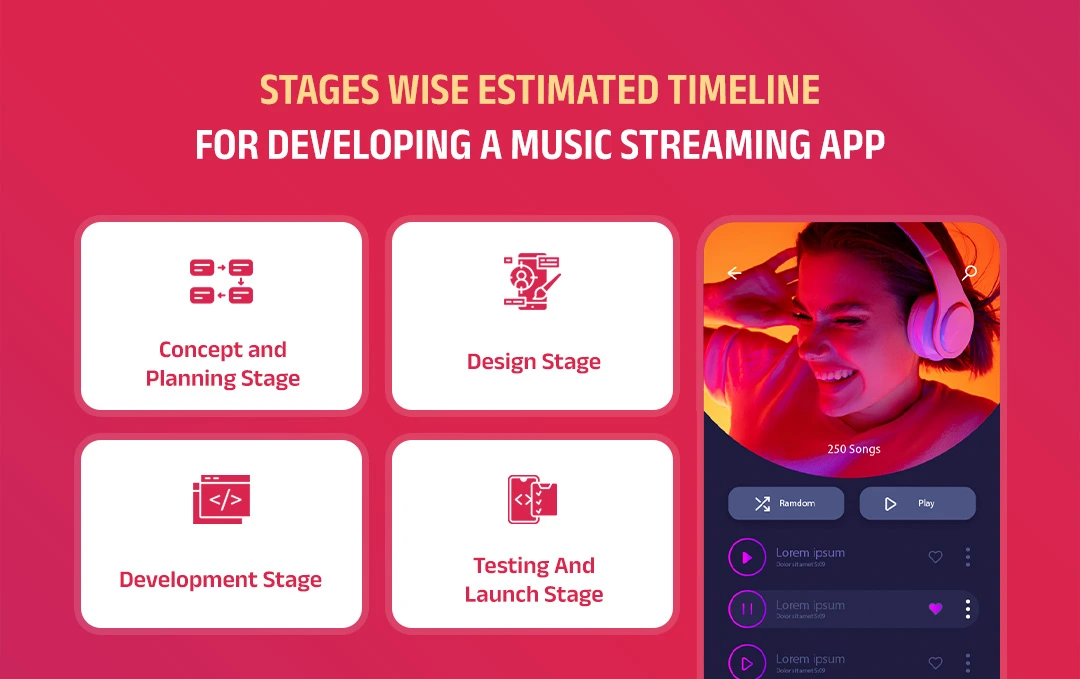
1. Concept and Planning Stage
The concept and planning stage is the first step in developing a music streaming app. During this phase, the development team creates a detailed plan for the app’s development, including the features, design, platform, and timeline. This stage can take anywhere from a few weeks to a few months, depending on the complexity of the app’s concept and the level of planning required.
2. Design Stage
Once the concept and planning stage is complete, the development team moves on to the design stage. In this stage, the team creates the visual design of the app, including the user interface (UI) and user experience (UX) design, and app icon design. The design stage can take anywhere from a few weeks to a few months, depending on the complexity of the app’s design.
3. Development Stage
The development stage is the most crucial stage in developing a music streaming app. In this stage, the development team codes the app and integrates the features and design elements. The timeline for the development stage can vary significantly, depending on the app’s complexity, platform, and development team’s experience. Generally, it takes around four to nine months to develop a basic music streaming app.
4. Testing and Launch Stage
After the development is complete, the app moves on to the testing and launch stage. In this stage, the app is tested for bugs and errors, and it is submitted to app stores for publication. Depending on the complexity of testing required and the platform where the app will be launched. Generally, it takes around one to two months to complete this stage.
5. Post-Launch Stage
Once the app is launched, the development team must continue to maintain and update the app to ensure that it is up-to-date and functioning correctly. The timeline for this stage can vary. Generally, ongoing maintenance and updates can take anywhere from a few months to a few years.
Overall, the timeline for developing a music streaming app can vary significantly depending on various factors. The development process can take anywhere from eight months to two years or more, depending on the application’s complexity, platform, and development team’s experience.
However, there are some factors that have an impact on the music streaming app development timeline. Let’s explore them.
Factors that Affect the Music Streaming App Development Timeline
Several factors can affect the timeline for developing a music streaming app like Pandora. These factors include:
1. The complexity of the app’s features: The more complex the app’s features, the longer it will take to develop the app.
2. Platform: Developing an app for multiple platforms, such as iOS and Android, will take longer than developing an app for a single platform.
3. Development team’s experience: A development team with more experience in music streaming app development will be able to complete the app more quickly.
4. Budget: The budget allocated for the development of the app can affect the timeline, as a larger budget may allow for more resources to be allocated to the project.
The development timeline for a music streaming app can vary depending on various factors, as discussed in the previous section. It is essential to plan the development process carefully and allocate the necessary resources to ensure the app’s quality and timely delivery. When working with Auxano Global Services’ app development team, you are ensured to get real results in the least possible duration while ensuring a successful app launch.
Conclusion
In conclusion, developing a music streaming app like Pandora can be a complex and challenging task, but it is a worthwhile investment for businesses looking to enter the digital music market. This blog covered several essential aspects of developing a music streaming app, including the costs, features, monetization strategies, and development timelines. There are many platforms that allow you to create your own music app, but it is always recommended to rely on professionals.
When it comes to developing a music streaming app, it is crucial to Hire Mobile App Developers that are reputable and experienced to ensure the app’s success. Auxano Global Services is one such company that has an excellent track record in developing high-quality apps for clients worldwide. Our experienced team of developers and designers can also ensure that the app’s development timeline is optimized, allowing for a timely and successful launch.
Frequently Asked Questions
-
1. How does Pandora work?
Pandora is a music streaming service that uses algorithms to create personalized playlists based on users’ music preferences. Users can create an account and select a favorite artist or song, and Pandora will generate a playlist with similar songs based on the user’s selection. Pandora’s algorithm analyzes users’ listening history and feedback to continuously adjust and improve the playlists’ accuracy.
Users can also create their own custom playlists or listen to pre-made genre-specific radio stations. Pandora offers both a free and a paid subscription service, with the paid service offering additional features like ad-free listening and unlimited skips.
-
2. What do I need to start a music streaming service like Pandora?
Starting a music streaming service like Pandora requires several key elements. First, you need a team of experienced developers who can create the app and backend infrastructure. This team should also include designers who can create an engaging user interface.
You will also need licensing agreements with music publishers and record labels to legally stream their music on your platform. These agreements can be complex and require legal expertise to negotiate.
To monetize your best audio streaming service, you will need to develop a comprehensive monetization strategy that includes in-app ads, paid subscriptions, promotions, or pay-per-album options. You should also conduct market research to identify your target audience and develop marketing strategies to promote your service.
Finally, you will need to invest in ongoing maintenance and updates to keep your app relevant and up-to-date with the latest industry trends and user preferences.
-
3. What are Monetization Strategies For Music Streaming App Like Pandora?
Monetization strategies for music streaming apps like Pandora can vary depending on the app’s goals and target audience. Some popular monetization strategies for music streaming apps include in-app ads, paid subscriptions, promotions, and pay-per-album.
-
4. What is the cost of creating a Pandora-like music streaming app?
The cost of developing a music streaming app like Pandora can vary depending on various factors, such as the features, platform, and complexity of the app. On average, the cost of developing a music streaming app can range from $40,000 to $250,000 or more. However, this is only a rough estimate, and the actual cost can vary depending on several factors.
-
5. What is the average time it takes to create a music streaming app like Pandora?
The average time it takes to develop a music streaming app like Pandora can vary depending on various factors, such as the app’s complexity, features, and platform. On average, it can take anywhere from eight months to two years or more to develop a music streaming app.



